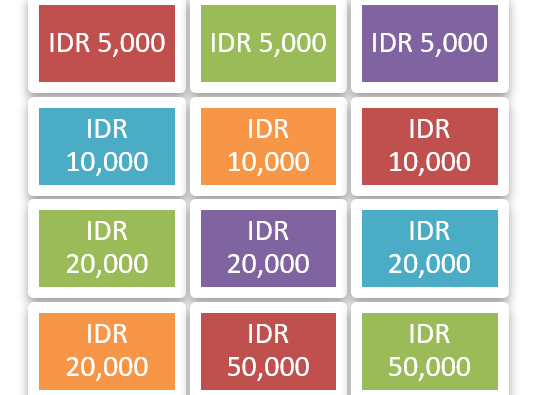Jeopardy classroom instruction: Fostering students’ motivation to learn English vocabulary
DOI:
https://doi.org/10.21070/jees.v6i1.1211Keywords:
learning motivation, Jeopardy, action research, vocabulary learning, gamificationAbstract
The issue, dealing with gamification to foster learners’ motivation and vocabulary in learning English, has been investigated recently. It is perceived that gamification will directly affect the teaching-learning process and determine the learning ambiance. This study aims to shed light on the extent of the employment of Jeopardy Classroom Instruction to foster EFL learners’ motivation to learn English vocabulary. The study deployed an action research method with three phases of pre-cycle, cycle 1, and cycle 2. Pre-cycle was to document the initial classroom condition before using Jeopardy Classroom Instruction, while cycle 1 and cycle 2 were for knowing the teaching-learning process situation during the use of Jeopardy Classroom Instruction. The participants were junior high school students. The data were collected through observation, closed-ended questionnaire, and students’ score. The results suggested that Jeopardy Classroom Instruction is an adjunct to aid students’ motivation to learn vocabulary. It helped students to acquire self-belief, learning focus, the value of learning, study management, planning and monitoring and persistence. Also, it mitigated some motivation guzzlers such as learning anxiety, low control, failure avoidance and self-sabotage that might hinder them from learning vocabulary.
HIGHLIGHTS:
- Jeopardy Classroom Instruction helped students to acquire self-belief, learning focus, the value of learning, study management, planning and monitoring and persistence.
- It mitigated some motivation guzzlers such as learning anxiety, low control, failure avoidance and self- sabotage that might hinder them from learning vocabulary.
Downloads
References
August, D., Carlo, M., Dressler, C., & Snow, C. (2005). The critical role of vocabulary development for English language learners. Learning Disabilities Research and Practice, 20(1), 50–57. https://doi.org/10.1111/j.1540-5826.2005.00120.x
Bee, S., & Hayes, D. C. (2005). Using the Jeopardy game to enhance student understanding of accounting information systems (AIS) exam material. Review of Business Information Systems (RBIS), 9(1), 69–78. https://doi.org/10.19030/rbis.v9i1.4471s
Benek-Rivera, J., & Mathews, V. E. (2004). Active Learning with Jeopardy: Students Ask the Questions. Journal of Management Education, 28(1), 104–118. https://doi.org/10.1177/1052562903252637
Beylefeld, A. A., & Struwig, M. C. (2007). A gaming approach to learning medical microbiology: Students’ experiences of flow. Medical Teacher, 29(9–10), 933–940. https://doi.org/10.1080/01421590701601550
Blakely, G., Skirton, H., Cooper, S., Allum, P., & Nelmes, P. (2009). Educational gaming in the health sciences: Systematic review. Journal of Advanced Nursing, 65(2), 259–269. https://doi.org/10.1111/j.1365-2648.2008.04843.x
Burns, A. (2010). Doing action research in English language teaching: A guide for practitioners. Routledge.
Dehghanzadeh, H., Fardanesh, H., Hatami, J., Talaee, E., & Noroozi, O. (2019). Using gamification to support learning English as a second language: a systematic review. In Computer Assisted Language Learning. (pp. 1–24). https://doi.org/10.1080/09588221.2019.1648298
Gardner, R. C. (1985). Social psychology and second language learning: The role of attitudes and motivation. E. Arnold.
Grady, S. E., Vest, K. M., & Todd, T. J. (2013). Student attitudes toward the use of games to promote learning in the large classroom setting. Currents in Pharmacy Teaching and Learning, 5(4), 263–268. https://doi.org/10.1016/j.cptl.2013.01.008
Jirasevijinda, T., & Brown, L. C. (2010). Jeopardy!©: An innovative approach to teach psychosocial aspects of pediatrics. Patient Education and Counseling, 80(3), 333–336. https://doi.org/10.1016/j.pec.2010.06.002
Kingsley, T. L., & Grabner-Hagen, M. M. (2018). Vocabulary by gamification. The Reading Teacher, 71(5), 545–555. https://doi.org/10.1002/trtr.1645
Leach, G. J., & Sugarman, T. S. (2005). Play to win! Using games in library instruction to enhance student learning. Research Strategies, 20(3), 191–203.
https://doi.org/10.1016/j.resstr.2006.05.002
Martin, A. J. (2003). The Student Motivation Scale: Further Testing of an Instrument that Measures School Students’ Motivation. Australian Journal of Education, 47(1), 88–106. https://doi.org/10.1177/000494410304700107
Nation, I. (2006). How large a vocabulary is needed for reading and listening? Canadian Modern Language Review, 63(1), 59–82. https://doi.org/10.3138/cmlr.63.1.59
Nation, Ian. (2020). Principles guiding vocabulary learning through extensive reading.
Peters, E., & Webb, S. (2018). Incidental vocabulary acquisition through viewing L2 television and factors that affect learning. Studies in Second Language Acquisition, 40(3), 551–577. https://doi.org/10.1017/S0272263117000407
Renandya, W. A., & Jacobs, G. M. (2016). Extensive reading and listening in the L2 classroom. In W. A. Renandya & H. P. Widodo (Eds.), English Language Teaching Today. (Vol. 5, pp. 97–110). Springer, Cham. https://doi.org/10.1007/978-3-319-38834-2_8
Revere, L. (2004). Classroom Jeopardy: A winning approach for improving student assessment, performance, and satisfaction. Decision Line, 35(3), 3–6.
Ryan, R. M., & Deci, E. L. (2000). Self-determination theory and the facilitation of intrinsic motivation, social development, and well-being. American Psychologist, 55(1), 68–78. https://doi.org/10.1037/0003-066X.55.1.68
Silberman, M. L. (1996). Active learning: 101 strategies to teach any subject. Allyn and Bacon.
Simkin, M. G. (2013). Playing Jeopardy in the Classroom: An Empirical Study. Journal of Information Systems Education, 24(3), 203.
Spolsky, B. (1998). Conditions for second language learning: Introduction to a general theory (4. impr). Oxford Univ. Press.
Webb, Stuart, & Rodgers, M. P. H. (2009). Vocabulary demands of television programs. Language Learning, 59(2), 335–366. https://doi.org/10.1111/j.1467-9922.2009.00509.x
Webb, S. (2015). Extensive viewing: Language learning through watching television. In Language Learning
Beyond the Classroom (D. Nunan & J.C. Richards). New York: Routledge.

Published
How to Cite
Issue
Section
License
Copyright (c) 2021 Widya Ratna Kusumaningrum, Endang Binarti

This work is licensed under a Creative Commons Attribution 4.0 International License.







